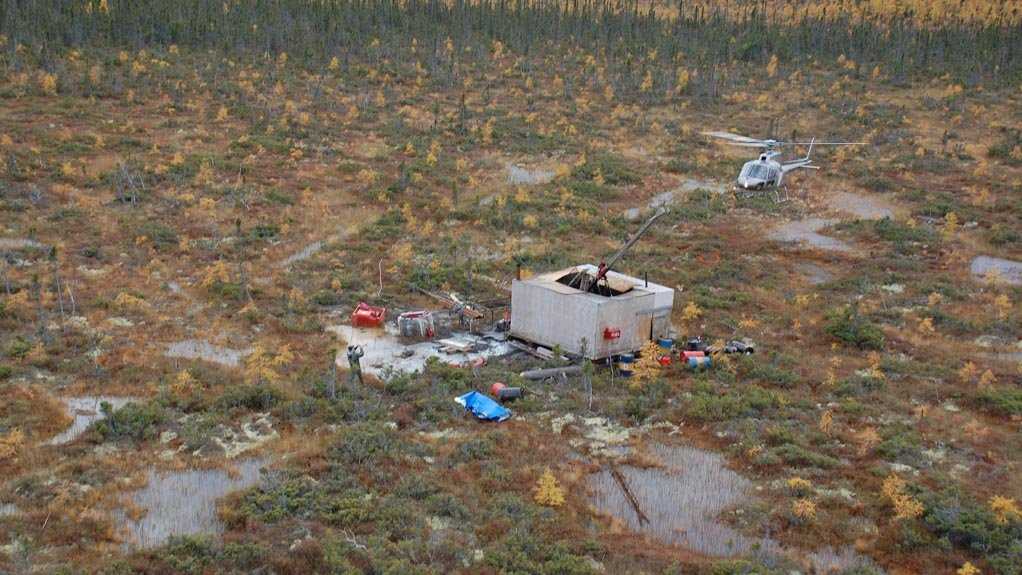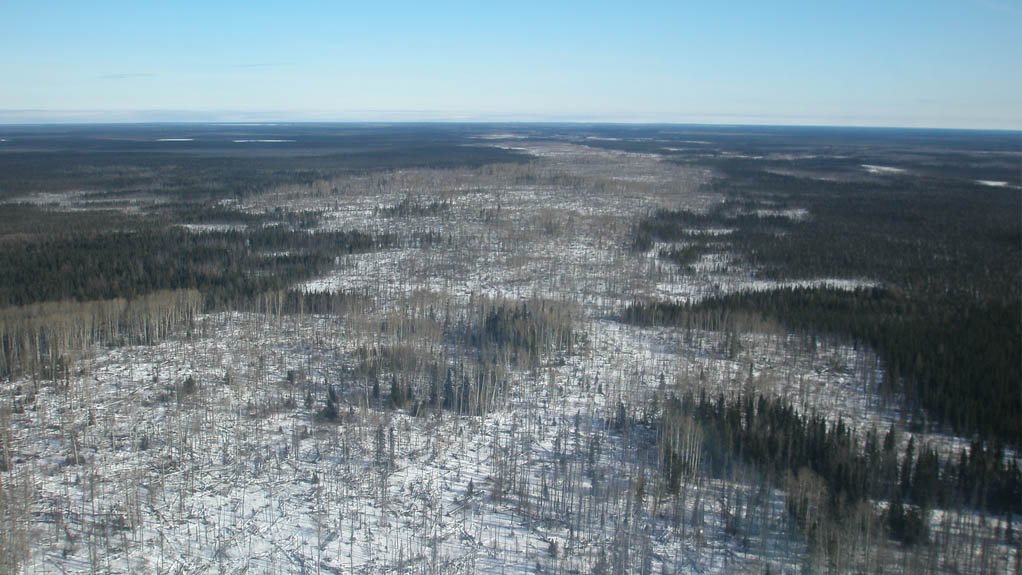Infrastructure a burning issue in Ontario’s remote Ring of Fire



Drilling at the Big Daddy deposit in which KWG has a 30% stake
KWG Resources, through a subsidiary, Canada Chrome Corporation, controls the key transportation route on land that it acquired through claim staking in 2009
In Ontario’s Far North, the mineral reserve dubbed the Ring of Fire has been hailed as one of the most promising mineral developments in the province in almost a century, with the largest deposit of chromite ever discovered in North America. This discovery has potential for decades, possibly a century, of chromite production, which could revitalise the North American stainless steel industry.
But the bustling region, where more than 20 companies hold claims, is located in the isolated McFaulds Lake area of the James Bay lowlands – more than 500 km from Thunder Bay – and needs infrastructure, most crucially transportation infrastructure, to turn it into Canada’s newest mining camp. It is estimated that the region needs about $2.25-billion in transportation and industrial infrastructure.
Transportation is seen as the number-one issue that could make or break the area’s potential and Maurice (Moe) Lavigne, the VP for exploration and development of TSX-V-listed KWG Resources, stresses that these chromite deposits will not progress to economic enterprises unless there is an efficient and affordable way out of the remote region.
Much of the debate around infrastructure has focused on which way the Ring of Fire should go – road or rail – and who should carry the cost of the infrastructure development and maintenance.
Both rail and road infrastructure will be expensive, as the Ring of Fire is stranded in a swampy area. KWG Resources, through a subsidiary, Canada Chrome Corporation, controls the key transportation route on land, which it acquired through claim staking in 2009. KWG has proposed a rail route connecting to the CN transcontinental rail line at the Exton rail siding to transport ore to consumers, which has set it on a collision course with its erstwhile US-based partner Cliffs Natural Resources, which has proposed an all-weather road south connecting to the same rail line west of Exton. Cliffs’ plan is to transport chromite concentrate by rail to Capreol, in the Sudbury area, where it plans to build a ferrochrome production facility.
The claims on the northern half of the 320 km transportation corridor cover the only ridge of high ground where road and rail is constructible.
The battle over a much-sought after corridor played itself out last year in front of the Ontario Mining and Land Commissioner, which, in the end, denied Cliffs access to KWG Resources’ staked mining claims to construct its proposed road. Although Cliffs is appealing the decision, it has suspended operations in the area, citing, among other reasons, uncertainty about developing the necessary infrastructure to bring its project on line.
“Rail is the best option economically and environmentally. While the initial capital costs are slightly higher, the operating costs and maintenance costs are substantially lower,” Lavigne tells Mining Weekly.
A study by international engineering firm TetraTech, which KWG commissioned, has demonstrated that lower cost per tonne haulage rates for rail will offset the higher capital expenditure (capex) of rail. It estimates the capital costs for a road will be about $1.05- billion and that of a railroad will be around $1.56-billion. If three-million tons a year are shipped, operating costs are estimated at $10.50/t for the railroad and $60.78/t for trucking on the road. If five-million tons a year are shipped, it is estimated that those operating costs per ton will be reduced to $6.33 for rail and $59.28 for trucking.
“The haulage rates are six times greater by road, thereby severely undermining project economics. The low haulage rates of rail also allow mine developers to consider transporting raw ore to processing sites established near existing communities, where both lower capex and opex [operating expenditure] more than offset extra transportation cost,” he says.
For the Ring of Fire to make its mark in the global market, production costs will have to match that of leading producers, such as South Africa, India and Kazakhstan, Lavigne states, adding that it is “entirely possible” that Canada’s future production will be “very competitive”. The country is also a politically stable jurisdiction, which, he says, counts in the Ring of Fire’s favour.
KWG believes the expansion of both a public rail network and public roads to extend into the Ring of Fire to service the needs of mine developers and First Nations will be the number-one prize for mining development in the region.
KWG has submitted proposals to the provincial and federal governments on a plan to set up an agency under the banner of the James Bay & Lowlands Ports Authority to take control of the Ontario Northland Transportation Commission (ONTC), which the province has proposed to liquidate. The plan, developed by the leadership of the ONTC’s unionised employees, proposes extending the Ontario Northland Railway network to serve the Ring of Fire.
“It is a natural fit for the ONTC, which is a major provincial holding in the north, to be involved in accessing the Ring of Fire. Converting the ONTC into an integrated transportation and communication system for both north-eastern and north-western Ontario makes sense and would also help improve the social and economic development of all communities in Northern Ontario,” Brian Kelly, spokesperson of the General Chairperson’s Association, which represents unionised employees at Ontario Northland, said in November.
It is proposed that the leadership of the Mushkegowuk and Matawa First Nations will govern the agency.
Development Corporation
KWG is supportive of the Development Corporation, which Ontario announced late last year to develop, construct, finance, operate and maintain infrastructure in the Ring of Fire. The corporation will seek to bring together private and public partners, including First Nations, mining companies, as well as the federal and provincial governments to determine what infrastructure will be most appropriate. Northern Development Minister Michael Gravelle has said that the corporation will look at all the current proposals on the table.
Lavigne believes the corporation should seek to develop a regional infrastructure network, not only to meet the needs of the mining companies, but also the needs of the communities in the remote area. “There needs to be a plan and the plan really needs to be driven by the Ontario government. That was what was needed from the very beginning, so I think the Development Corporation will be a vehicle that could deliver on it,” he comments.
Lavigne has expressed his hope that, by the next winter, the region will start seeing “development on the ground” for transport infrastructure and that, by spring, permissible plans start to develop.
Cliffs, which announced the indefinite suspension of its $3.3-billion Black Thor project in November, has said that it continues to believe in the value of the mineral deposits and the potential of the Ring of Fire region and that it too will participate in discussions with the Development Corporation.
KWG does not believe that Cliffs’ decision to indefinitely halt environmental assessment work on its project will threaten development in the Ring of Fire. Lavigne points out that Noront Resources is moving ahead with the development of its Eagle’s Nest nickel mine and that KWG is continuing to develop the Black Horse deposit.
The Black Horse deposit – in which KWG has the right to earn an 80% stake – is “shaping up to be the most attractive chrome deposit in the Ring of Fire”, Lavigne says. Using a 20% cutoff, it currently has an inferred resource of 46.5-million tons at a grade of 38.8%. By comparison, Cliffs’ Big Daddy deposit – in which KWG has a 30% stake – has a resource of 32-million tons at a grade of 31%, using a 20% cutoff.
KWG continues to invest heavily in the expansion of its resource at Black Horse and on a new method of refining the chromite of the deposit into ferrochrome by means of natural gas. “We expect to be in a position to advance the project to the development stage by the second quarter of 2014,” he says.
Black Horse is close to Noront Resources’ Eagle’s Nest nickel, copper, platinum and palladium deposit and the companies are exploring synergies, such as shared underground infrastructure, between the operations. “We are investigating the synergies of mining the two deposits, as well as the Blackbird deposit in one big shot,” Lavigne says, but adds that it is a long-term plan, as Black Horse is still at an early exploration stage and not at a point yet where it could do a prefeasibility study.
Noront Resources CEO Alan Coutts believes that Eagle’s Nest will be the first mine developed in the Ring of Fire. The company has completed a federal/provincial environmental-impact statement and environmental assessment report for the project. The report includes baseline environmental studies that examine the mine site, the access road corridor and a railcar loading site.
First Nations and Environmental Concerns
Although considered a make or break issue, transport infrastructure is not the only issue weighing on the minds of explorers and developers in the region. Deals also have to be made between governments and First Nations. The Far North holds the traditional territories of 38 First Nation communities.
Ontario has appointed former Supreme Court of Canada Judge Frank Iacobucci as its lead negotiator dealing with First Nations in Ring of Fire development. Matawa First Nation chiefs have appointed former Ontario Premier Bob Rae, who retired from politics in June, their lead negotiator.
The issues on the negotiating table are environmental protection and monitoring; regional infrastructure planning and development; resource revenue sharing and social and economic support.
Matawa chiefs believe that the current environmental assessment process does not allow for proper consultation with First Nations and that it has an inappropriate timeline.
Ontario’s Environmental Commissioner Gord Miller has warned of irreversible damage to the wildlife and wilderness of the Far North unless research is done and environmental protections are put in place.
“Right now, environmental assessments are done on a piecemeal, project-by-project basis. They do not take into account the combined effect of all the individual mines, roads, transmission corridors, airstrips and other impacts that will have profound effects on the Far North and many First Nation communities.”
Ontario’s Far North is recognised as being of global ecological significance, Miller says, adding that this part of the province is threatened by advancing development in the absence of proper planning, especially in the Ring of Fire. “We have one chance to get things right in the Far North. It’s imperative that the Ontario government makes sound choices about the Ring of Fire, and that these choices are anchored in solid knowledge of what’s going on there.”
The commissioner concedes that road and rail access will create a new world of possibilities for the Far North, opening a new frontier for exploration, development and activities like hunting and fishing, but questions what the development will mean for the largely pristine, intact ecosystem of the Far North.
The region is a stronghold for biodiversity, its peatlands are important carbon stores and its forests comprise part of the largest block of boreal forest still free from large-scale human disturbance anywhere in the world.
The Environmental Commissioner’s report lists some potential environmental effects of mining and mining-related infrastructure in the Ring of Fire that should be evaluated, including, among others, the potential impact that mines will have on the habitat of species, such as caribou, wolverine and sturgeon, and the impact on groundwater flows and wetlands. It also says that the impact of associated infrastructure, such as all-season roads or railways, should be evaluated. It lists concerns such as the fragmentation of both terrestrial and aquatic habitat; ongoing disturbance to wildlife owing to noise, traffic and dust; impacts on stream morphology and flow; increased access and traffic to wilderness areas; increasing fishing and hunting pressure; fragmentation and disturbance of major rivers, wetland areas and protected areas; and increased greenhouse-gas emissions from transportation fuels.
Visit KWG Resources at PDAC 2014 at booth # 2728.
Comments
Press Office
Announcements
What's On
Subscribe to improve your user experience...
Option 1 (equivalent of R125 a month):
Receive a weekly copy of Creamer Media's Engineering News & Mining Weekly magazine
(print copy for those in South Africa and e-magazine for those outside of South Africa)
Receive daily email newsletters
Access to full search results
Access archive of magazine back copies
Access to Projects in Progress
Access to ONE Research Report of your choice in PDF format
Option 2 (equivalent of R375 a month):
All benefits from Option 1
PLUS
Access to Creamer Media's Research Channel Africa for ALL Research Reports, in PDF format, on various industrial and mining sectors
including Electricity; Water; Energy Transition; Hydrogen; Roads, Rail and Ports; Coal; Gold; Platinum; Battery Metals; etc.
Already a subscriber?
Forgotten your password?
Receive weekly copy of Creamer Media's Engineering News & Mining Weekly magazine (print copy for those in South Africa and e-magazine for those outside of South Africa)
➕
Recieve daily email newsletters
➕
Access to full search results
➕
Access archive of magazine back copies
➕
Access to Projects in Progress
➕
Access to ONE Research Report of your choice in PDF format
RESEARCH CHANNEL AFRICA
R4500 (equivalent of R375 a month)
SUBSCRIBEAll benefits from Option 1
➕
Access to Creamer Media's Research Channel Africa for ALL Research Reports on various industrial and mining sectors, in PDF format, including on:
Electricity
➕
Water
➕
Energy Transition
➕
Hydrogen
➕
Roads, Rail and Ports
➕
Coal
➕
Gold
➕
Platinum
➕
Battery Metals
➕
etc.
Receive all benefits from Option 1 or Option 2 delivered to numerous people at your company
➕
Multiple User names and Passwords for simultaneous log-ins
➕
Intranet integration access to all in your organisation



















